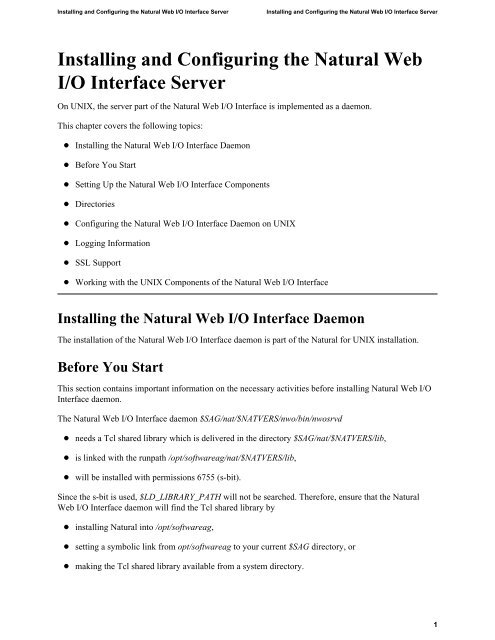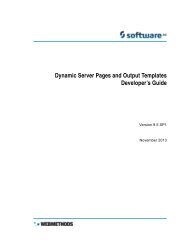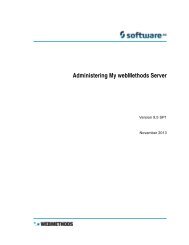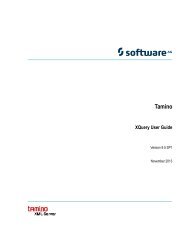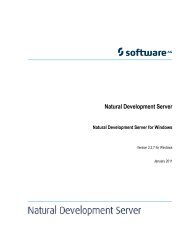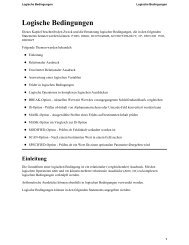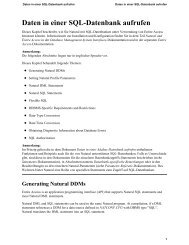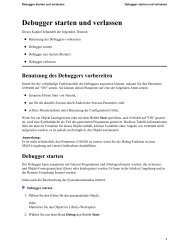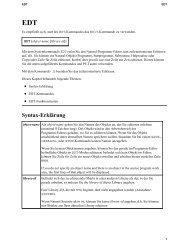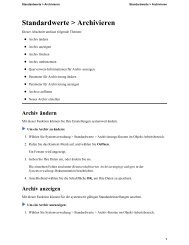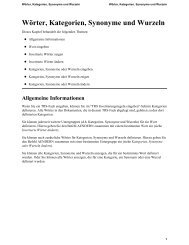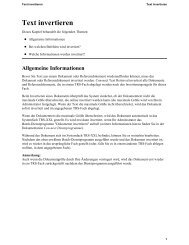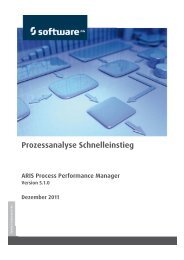Installing and Configuring the Natural Web I/O Interface Server
Installing and Configuring the Natural Web I/O Interface Server
Installing and Configuring the Natural Web I/O Interface Server
You also want an ePaper? Increase the reach of your titles
YUMPU automatically turns print PDFs into web optimized ePapers that Google loves.
<strong>Installing</strong> <strong>and</strong> <strong>Configuring</strong> <strong>the</strong> <strong>Natural</strong> <strong>Web</strong> I/O <strong>Interface</strong> <strong>Server</strong><br />
<strong>Installing</strong> <strong>and</strong> <strong>Configuring</strong> <strong>the</strong> <strong>Natural</strong> <strong>Web</strong><br />
I/O <strong>Interface</strong> <strong>Server</strong><br />
On UNIX, <strong>the</strong> server part of <strong>the</strong> <strong>Natural</strong> <strong>Web</strong> I/O <strong>Interface</strong> is implemented as a daemon.<br />
This chapter covers <strong>the</strong> following topics:<br />
<strong>Installing</strong> <strong>the</strong> <strong>Natural</strong> <strong>Web</strong> I/O <strong>Interface</strong> Daemon<br />
Before You Start<br />
Setting Up <strong>the</strong> <strong>Natural</strong> <strong>Web</strong> I/O <strong>Interface</strong> Components<br />
Directories<br />
<strong>Configuring</strong> <strong>the</strong> <strong>Natural</strong> <strong>Web</strong> I/O <strong>Interface</strong> Daemon on UNIX<br />
Logging Information<br />
SSL Support<br />
Working with <strong>the</strong> UNIX Components of <strong>the</strong> <strong>Natural</strong> <strong>Web</strong> I/O <strong>Interface</strong><br />
<strong>Installing</strong> <strong>the</strong> <strong>Natural</strong> <strong>Web</strong> I/O <strong>Interface</strong> Daemon<br />
The installation of <strong>the</strong> <strong>Natural</strong> <strong>Web</strong> I/O <strong>Interface</strong> daemon is part of <strong>the</strong> <strong>Natural</strong> for UNIX installation.<br />
Before You Start<br />
This section contains important information on <strong>the</strong> necessary activities before installing <strong>Natural</strong> <strong>Web</strong> I/O<br />
<strong>Interface</strong> daemon.<br />
The <strong>Natural</strong> <strong>Web</strong> I/O <strong>Interface</strong> daemon $SAG/nat/$NATVERS/nwo/bin/nwosrvd<br />
needs a Tcl shared library which is delivered in <strong>the</strong> directory $SAG/nat/$NATVERS/lib,<br />
is linked with <strong>the</strong> runpath /opt/softwareag/nat/$NATVERS/lib,<br />
will be installed with permissions 6755 (s-bit).<br />
Since <strong>the</strong> s-bit is used, $LD_LIBRARY_PATH will not be searched. Therefore, ensure that <strong>the</strong> <strong>Natural</strong><br />
<strong>Web</strong> I/O <strong>Interface</strong> daemon will find <strong>the</strong> Tcl shared library by<br />
installing <strong>Natural</strong> into /opt/softwareag,<br />
setting a symbolic link from opt/softwareag to your current $SAG directory, or<br />
making <strong>the</strong> Tcl shared library available from a system directory.<br />
<strong>Installing</strong> <strong>and</strong> <strong>Configuring</strong> <strong>the</strong> <strong>Natural</strong> <strong>Web</strong> I/O <strong>Interface</strong> <strong>Server</strong><br />
1
<strong>Installing</strong> <strong>and</strong> <strong>Configuring</strong> <strong>the</strong> <strong>Natural</strong> <strong>Web</strong> I/O <strong>Interface</strong> <strong>Server</strong><br />
Setting Up <strong>the</strong> <strong>Natural</strong> <strong>Web</strong> I/O <strong>Interface</strong> Components<br />
Setting up <strong>the</strong> <strong>Natural</strong> <strong>Web</strong> I/O <strong>Interface</strong> on UNIX consists of <strong>the</strong> following steps:<br />
Step 1: Stop <strong>the</strong> <strong>Natural</strong> <strong>Web</strong> I/O <strong>Interface</strong> Daemons<br />
Step 2: Establish <strong>the</strong> Environment<br />
Step 3: Install <strong>Natural</strong> <strong>and</strong> <strong>the</strong> <strong>Natural</strong> <strong>Web</strong> I/O <strong>Interface</strong><br />
Step 4: Check <strong>the</strong> Environment Variables for <strong>the</strong> <strong>Natural</strong> <strong>Web</strong> I/O <strong>Interface</strong><br />
Step 5: Read <strong>the</strong> READ_NWO Files<br />
Step 1: Stop <strong>the</strong> <strong>Natural</strong> <strong>Web</strong> I/O <strong>Interface</strong> Daemons<br />
This step is only required for an upgrade installation. It is not required when you install <strong>the</strong> <strong>Natural</strong> <strong>Web</strong><br />
I/O <strong>Interface</strong> for <strong>the</strong> first time.<br />
1. Stop <strong>the</strong> nwosrvd process using <strong>the</strong> following comm<strong>and</strong>:<br />
nwosrvd.sh portnumber stop<br />
Or use <strong>the</strong> script $NATDIR/$NATVERS/INSTALL/nwosrvd.bsh which will be generated during <strong>the</strong><br />
<strong>Natural</strong> <strong>Web</strong> I/O <strong>Interface</strong> installation for a specified port.<br />
nwosrvd.bsh stop<br />
2. Repeat <strong>the</strong> above comm<strong>and</strong> (with an adapted port in script nwosrvd.bsh, if applicable) for each<br />
<strong>Natural</strong> <strong>Web</strong> I/O <strong>Interface</strong> service that is needed.<br />
Step 2: Establish <strong>the</strong> Environment<br />
2<br />
Ensure that <strong>the</strong> environment settings in <strong>the</strong> file sagenv.new are correct <strong>and</strong> set. Note that <strong>the</strong> nwoenv<br />
environment script will be called by <strong>the</strong> natenv environment script.<br />
Or use <strong>the</strong> shell script nwoenv.csh by entering <strong>the</strong> following comm<strong>and</strong>:<br />
source nwoenv.csh<br />
Setting Up <strong>the</strong> <strong>Natural</strong> <strong>Web</strong> I/O <strong>Interface</strong> Components<br />
This script can be found after <strong>the</strong> installation in $NATDIR/$NATVERS/INSTALL.
Directories<br />
Step 3: Install <strong>Natural</strong> <strong>and</strong> <strong>the</strong> <strong>Natural</strong> <strong>Web</strong> I/O <strong>Interface</strong><br />
The <strong>Natural</strong> <strong>Web</strong> I/O <strong>Interface</strong> can be selected in <strong>the</strong> Choose Packages screen during <strong>the</strong> <strong>Natural</strong><br />
installation.<br />
Optionally, you may install a runlevel script to start/stop a <strong>Natural</strong> <strong>Web</strong> I/O <strong>Interface</strong> daemon <strong>and</strong><br />
start <strong>the</strong> <strong>Natural</strong> <strong>Web</strong> I/O <strong>Interface</strong> daemon on a specified port. After <strong>the</strong> <strong>Natural</strong> installation has<br />
finished, <strong>the</strong> <strong>Natural</strong> <strong>Web</strong> I/O <strong>Interface</strong> must be activated by starting <strong>Natural</strong> through a <strong>Natural</strong> <strong>Web</strong><br />
I/O <strong>Interface</strong> client on Windows.<br />
When a runlevel script is used, <strong>the</strong> <strong>Natural</strong> <strong>Web</strong> I/O <strong>Interface</strong> daemon can only be administered by<br />
<strong>the</strong> user "root".<br />
When you install <strong>Natural</strong> with <strong>the</strong> <strong>Natural</strong> <strong>Web</strong> I/O <strong>Interface</strong>, <strong>the</strong> directory<br />
$NATDIR/nwo/$NWONODE is created. The template files located in<br />
$NATDIR/$NATVERS/nwo/node-name are <strong>the</strong>n copied to this new directory.<br />
Step 4: Check <strong>the</strong> Environment Variables for <strong>the</strong> <strong>Natural</strong> <strong>Web</strong> I/O <strong>Interface</strong><br />
The <strong>Natural</strong> <strong>Web</strong> I/O <strong>Interface</strong>-specific settings are shown below:<br />
Environment<br />
Variable<br />
Description<br />
NWODIR The home directory for <strong>the</strong> product located at<br />
$NATDIR/$NATVERS/nwo.<br />
NWONODE The name of <strong>the</strong> node on which <strong>the</strong> <strong>Natural</strong> <strong>Web</strong> I/O <strong>Interface</strong><br />
is installed.<br />
NWO_SRVDCONF The configuration file<br />
$NATDIR/nwo/$NWONODE/nwosrvd.conf for <strong>the</strong> <strong>Natural</strong><br />
<strong>Web</strong> I/O <strong>Interface</strong> daemon.<br />
NWO_TIMEOUT The maximum time, in seconds, that <strong>the</strong> <strong>Natural</strong> <strong>Web</strong> I/O<br />
<strong>Interface</strong> daemon will wait for a response. "0" means no<br />
timeout. The <strong>Natural</strong> <strong>Web</strong> I/O <strong>Interface</strong> daemon will terminate<br />
when it receives <strong>the</strong> timeout.<br />
Step 5: Read <strong>the</strong> READ_NWO Files<br />
1. Access <strong>the</strong> directory $NATDIR/$NATVERS <strong>and</strong> check <strong>the</strong> files READ_NWO.TXT <strong>and</strong><br />
READ_NWO.FIX for any version-specific installation considerations concerning <strong>the</strong> particular<br />
platform.<br />
2. Add <strong>the</strong> services as described in <strong>the</strong> file READ_NWO.TXT.<br />
Directories<br />
<strong>Installing</strong> <strong>and</strong> <strong>Configuring</strong> <strong>the</strong> <strong>Natural</strong> <strong>Web</strong> I/O <strong>Interface</strong> <strong>Server</strong><br />
The following directories are created when <strong>Natural</strong> is installed toge<strong>the</strong>r with <strong>the</strong> <strong>Natural</strong> <strong>Web</strong> I/O<br />
<strong>Interface</strong> on a UNIX system:<br />
3
<strong>Installing</strong> <strong>and</strong> <strong>Configuring</strong> <strong>the</strong> <strong>Natural</strong> <strong>Web</strong> I/O <strong>Interface</strong> <strong>Server</strong><br />
Directory Description<br />
$NATDIR Top-level <strong>Natural</strong> directory.<br />
$NATDIR/$NATVERS Directory with all components for <strong>the</strong> current <strong>Natural</strong> version.<br />
$NWODIR Directory with <strong>the</strong> <strong>Natural</strong> <strong>Web</strong> I/O <strong>Interface</strong> components for <strong>the</strong><br />
current version.<br />
$NWONODE Contains <strong>the</strong> name of <strong>the</strong> machine (uname -n).<br />
$NATDIR/$NATVERS/INSTALL Shell scripts <strong>and</strong> environment files for <strong>the</strong> <strong>Natural</strong> <strong>Web</strong> I/O <strong>Interface</strong><br />
(nwoenv, nwoenv.csh).<br />
$NWODIR/bin <strong>Natural</strong> <strong>Web</strong> I/O <strong>Interface</strong> executable files (nwosrvd, nwosrvd.tr).<br />
$NWODIR/node-name Contains <strong>the</strong> template files (nwosrvd.sh, nwo.sh, nwosrvd.conf).<br />
$NWODIR/nwoexuex/userexit1 Contains <strong>the</strong> files for building <strong>the</strong> libnwouserexit1.<br />
$NWODIR/nwoexuex/userexit2 Contains <strong>the</strong> files for building <strong>the</strong> libnwouserexit2.<br />
$NATDIR/nwo/$NWONODE Work directory, contains <strong>the</strong> configuration files (nwosrvd.sh, nwo.sh,<br />
nwosrvd.conf).<br />
Note:<br />
The above table lists <strong>the</strong> most important directories <strong>and</strong> files.<br />
<strong>Configuring</strong> <strong>the</strong> <strong>Natural</strong> <strong>Web</strong> I/O <strong>Interface</strong> Daemon on<br />
UNIX<br />
When <strong>the</strong> <strong>Natural</strong> installation has finished, <strong>the</strong> directory $NATDIR/nwo/$NWONODE contains <strong>the</strong> files<br />
nwosrvd.conf, nwosrvd.sh <strong>and</strong> nwo.sh.<br />
The configuration of <strong>the</strong> <strong>Natural</strong> <strong>Web</strong> I/O <strong>Interface</strong> daemon can be done using <strong>the</strong> <strong>Natural</strong> <strong>Web</strong> I/O<br />
<strong>Interface</strong> daemon comm<strong>and</strong>s or by editing <strong>the</strong> configuration file nwosrvd.conf.<br />
The following topics are covered below:<br />
<strong>Natural</strong> <strong>Web</strong> I/O <strong>Interface</strong> Daemon Comm<strong>and</strong>s<br />
nwosrvd.conf - Configuration File for <strong>the</strong> <strong>Natural</strong> <strong>Web</strong> I/O <strong>Interface</strong> Daemon<br />
nwosrvd.sh - Shell Script for Starting <strong>and</strong> Stopping <strong>the</strong> <strong>Natural</strong> <strong>Web</strong> I/O <strong>Interface</strong> Daemon<br />
nwo.sh - Shell Script for Starting <strong>Natural</strong><br />
Environment Variables<br />
<strong>Natural</strong> <strong>Web</strong> I/O <strong>Interface</strong> Daemon Comm<strong>and</strong>s<br />
The following comm<strong>and</strong>s can be specified at <strong>the</strong> UNIX comm<strong>and</strong> prompt:<br />
4<br />
<strong>Configuring</strong> <strong>the</strong> <strong>Natural</strong> <strong>Web</strong> I/O <strong>Interface</strong> Daemon on UNIX
<strong>Natural</strong> <strong>Web</strong> I/O <strong>Interface</strong> Daemon Comm<strong>and</strong>s<br />
Comm<strong>and</strong> Description<br />
nwosrvd –help Shows all available <strong>Natural</strong> <strong>Web</strong> I/O <strong>Interface</strong> daemon comm<strong>and</strong>s <strong>and</strong><br />
subcomm<strong>and</strong>s.<br />
nwosrvd –v Shows <strong>the</strong> version of <strong>the</strong> <strong>Natural</strong> <strong>Web</strong> I/O <strong>Interface</strong> daemon.<br />
nwosrvd nnnn Defines <strong>the</strong> listening port number.<br />
nwosrvd –show Shows <strong>the</strong> configuration of <strong>the</strong> <strong>Natural</strong> <strong>Web</strong> I/O <strong>Interface</strong> daemon.<br />
<strong>Installing</strong> <strong>and</strong> <strong>Configuring</strong> <strong>the</strong> <strong>Natural</strong> <strong>Web</strong> I/O <strong>Interface</strong> <strong>Server</strong><br />
5
<strong>Installing</strong> <strong>and</strong> <strong>Configuring</strong> <strong>the</strong> <strong>Natural</strong> <strong>Web</strong> I/O <strong>Interface</strong> <strong>Server</strong><br />
Comm<strong>and</strong> Description<br />
nwosrvd -config<br />
keys<br />
6<br />
Changes <strong>the</strong> configuration of <strong>the</strong> <strong>Natural</strong> <strong>Web</strong> I/O <strong>Interface</strong> daemon.<br />
The following keys can be specified:<br />
-userexit1=pathname<br />
The message defined with this key is saved in <strong>the</strong> UserExit1<br />
key of <strong>the</strong> configuration file nwosrvd.conf, section<br />
[UserExits].<br />
–userexit2=pathname<br />
The message defined with this key is saved in <strong>the</strong> UserExit2<br />
key of <strong>the</strong> configuration file nwosrvd.conf, section<br />
[UserExits].<br />
–passparam=parameters<br />
The message defined with this key is saved in <strong>the</strong> Parameters<br />
key of <strong>the</strong> configuration file nwosrvd.conf, section<br />
[PasswdArguments].<br />
–passold=message<br />
The message defined with this key is saved in <strong>the</strong><br />
EnterOldPassword key of <strong>the</strong> configuration file<br />
nwosrvd.conf, section [PasswdMessages].<br />
–passnew=message<br />
The message defined with this key is saved in <strong>the</strong> NewPassword<br />
key of <strong>the</strong> configuration file nwosrvd.conf, section<br />
[PasswdMessages].<br />
–passreenter=message<br />
The message defined with this key is saved in <strong>the</strong><br />
ReEnterNewPassword key of <strong>the</strong> configuration file<br />
nwosrvd.conf, section [PasswdMessages].<br />
–passsuccess=message<br />
The message defined with this key is saved in <strong>the</strong><br />
PasswordSuccessful key of <strong>the</strong> configuration file<br />
nwosrvd.conf, section [PasswdMessages].<br />
–logging=option<br />
The option defined with this key is saved in <strong>the</strong> Logging key of<br />
<strong>the</strong> configuration file nwosrvd.conf, section<br />
[Miscellaneous].<br />
-ssl=[yes|no]<br />
The option defined with this key is saved in <strong>the</strong> ssl key of <strong>the</strong><br />
configuration file nwosrvd.conf, section [SSL].<br />
To remove any user exits from <strong>the</strong> configuration, enter <strong>the</strong> following<br />
comm<strong>and</strong>:<br />
nwosrvd –config –userexit1=<br />
Once <strong>the</strong> configuration was changed, <strong>the</strong> <strong>Natural</strong> <strong>Web</strong> I/O <strong>Interface</strong><br />
daemon must be restarted.<br />
<strong>Natural</strong> <strong>Web</strong> I/O <strong>Interface</strong> Daemon Comm<strong>and</strong>s
nwosrvd.conf - Configuration File for <strong>the</strong> <strong>Natural</strong> <strong>Web</strong> I/O <strong>Interface</strong> Daemon<br />
nwosrvd.conf - Configuration File for <strong>the</strong> <strong>Natural</strong> <strong>Web</strong> I/O <strong>Interface</strong> Daemon<br />
The configuration file nwosrvd.conf contains information that <strong>the</strong> user exits need for <strong>the</strong> <strong>Natural</strong> <strong>Web</strong> I/O<br />
<strong>Interface</strong> daemon. It has <strong>the</strong> following content:<br />
[Miscellaneous]<br />
Logging=I<br />
[UserExits]<br />
; UserExit1=/FS/sag/nat/nwoexuex/userexit1/libnwouserexit1.so<br />
; UserExit2=/FS/sag/nat/nwoexuex/userexit2/libnwouserexit2.so<br />
[PasswdArguments]<br />
Parameters=<br />
[PasswdMessages]<br />
EnterOldPassword=Enter existing login password:<br />
NewPassword=New Password:<br />
ReEnterNewPassword=Re-enter new Password:<br />
PasswordSuccessful=passwd: password successfully changed for*<br />
[SSL]<br />
ssl=no<br />
Section in<br />
Configuration File<br />
Description<br />
[Miscellaneous] The key Logging is used to define <strong>the</strong> amount of logging information<br />
that is to be reported. One of <strong>the</strong> following options can be specified:<br />
E for errors.<br />
W for warnings.<br />
I for information.<br />
See also Logging Information.<br />
<strong>Installing</strong> <strong>and</strong> <strong>Configuring</strong> <strong>the</strong> <strong>Natural</strong> <strong>Web</strong> I/O <strong>Interface</strong> <strong>Server</strong><br />
7
<strong>Installing</strong> <strong>and</strong> <strong>Configuring</strong> <strong>the</strong> <strong>Natural</strong> <strong>Web</strong> I/O <strong>Interface</strong> <strong>Server</strong><br />
Section in<br />
Configuration File<br />
8<br />
Description<br />
[UserExits] Two user exits can be defined:<br />
UserExit1<br />
The library that is defined by UserExit1 contains <strong>the</strong> following<br />
function:<br />
int nwo_CheckUsernameAndPassword(const char<br />
*pUsername, const char *pPassword, const char<br />
*pNewPassword, char *pErrorMessage)<br />
If <strong>the</strong> key UserExit1 is defined in <strong>the</strong> configuration file, <strong>the</strong> function<br />
nwo_CheckUsernameAndPassword is responsible for checking <strong>the</strong><br />
user name <strong>and</strong> password. If a new password is received, user exit 1 is also<br />
responsible for changing <strong>the</strong> password.<br />
In <strong>the</strong> case of an error, <strong>the</strong> return code of <strong>the</strong> function must be "0"; in this<br />
case, <strong>the</strong> pErrorMessage is returned to <strong>the</strong> client. When user name <strong>and</strong><br />
password are correct, <strong>the</strong> return code must be a value o<strong>the</strong>r than "0".<br />
UserExit2<br />
The library that is defined by UserExit2 contains <strong>the</strong> following<br />
functions:<br />
int nwo_Messages(int *iNumberOfMessages, char<br />
*pMessage[])<br />
iNumberOfMessages: Number of messages returned in <strong>the</strong> array.<br />
pMessage: Array of messages.<br />
If <strong>the</strong> key UserExit2 is defined in <strong>the</strong> configuration file, <strong>the</strong><br />
function nwo_Messages is called when a new connection (client) is<br />
accepted <strong>and</strong> <strong>the</strong> messages returned by this function are sent to <strong>the</strong><br />
client. User exit 2 may be used, for example, to send a message such<br />
as <strong>the</strong> following: "For maintenance reasons, <strong>the</strong> <strong>Natural</strong> application<br />
XXXXX will be down next monday, from 18:00 until 19:00".<br />
In <strong>the</strong> case of an error, <strong>the</strong> return code of <strong>the</strong> function must be "0".<br />
After <strong>the</strong> function nwo_Messages has been called, <strong>the</strong> function<br />
nwo_FreeMessages is called.<br />
int nwo_FreeMessages(int iNumberOfMessages,<br />
char *pMessage[])<br />
iNumberOfMessages: Number of messages.<br />
pMessage: Array of messages.<br />
nwosrvd.conf - Configuration File for <strong>the</strong> <strong>Natural</strong> <strong>Web</strong> I/O <strong>Interface</strong> Daemon<br />
If <strong>the</strong> key UserExit2 is defined, <strong>the</strong> function<br />
nwo_FreeMessages is called to free any resources (normally<br />
memory) allocated in <strong>the</strong> function nwo_Messages.<br />
In <strong>the</strong> case of an error, <strong>the</strong> return code of <strong>the</strong> function must be "0".<br />
[PasswdArguments] The key Parameters is used to define any additional parameter(s) that<br />
have to be passed to <strong>the</strong> passwd comm<strong>and</strong>.
nwosrvd.sh - Shell Script for Starting <strong>and</strong> Stopping <strong>the</strong> <strong>Natural</strong> <strong>Web</strong> I/O <strong>Interface</strong> Daemon<br />
Section in<br />
Configuration File<br />
Description<br />
[PasswdMessages] The keys in this section define <strong>the</strong> messages that are to be returned by <strong>the</strong><br />
system (passwd comm<strong>and</strong>) when a user changes <strong>the</strong> password. If any of<br />
<strong>the</strong>se messages is not identified by <strong>the</strong> daemon, an error will be returned to<br />
<strong>the</strong> client.<br />
Password Mechanism<br />
The password <strong>and</strong> new password are encrypted on <strong>the</strong> client side <strong>and</strong><br />
decrypted on <strong>the</strong> UNIX side. A maximum of 8 characters is allowed.<br />
If user exit 1 is active, user name, password <strong>and</strong> new password are passed<br />
to <strong>the</strong> user exit.<br />
If user exit 1 is not active, <strong>the</strong> daemon checks whe<strong>the</strong>r user name <strong>and</strong><br />
password are correct for <strong>the</strong> system. If a new password is sent, <strong>the</strong> daemon<br />
changes <strong>the</strong> password by calling <strong>the</strong> UNIX comm<strong>and</strong> passwd.<br />
[SSL] The key ssl is used to define whe<strong>the</strong>r <strong>the</strong> SSL protocol is to be used. One<br />
of <strong>the</strong> following values can be specified: "yes" or "no".<br />
See also SSL Support.<br />
nwosrvd.sh - Shell Script for Starting <strong>and</strong> Stopping <strong>the</strong> <strong>Natural</strong> <strong>Web</strong> I/O<br />
<strong>Interface</strong> Daemon<br />
The shell script nwosrvd.sh is used to start <strong>and</strong> stop <strong>the</strong> <strong>Natural</strong> <strong>Web</strong> I/O <strong>Interface</strong> daemon. For fur<strong>the</strong>r<br />
information, see Starting <strong>and</strong> Stopping <strong>the</strong> <strong>Natural</strong> <strong>Web</strong> I/O <strong>Interface</strong> Daemon.<br />
nwo.sh - Shell Script for Starting <strong>Natural</strong><br />
In order to start a <strong>Natural</strong> session, <strong>the</strong> <strong>Natural</strong> <strong>Web</strong> I/O <strong>Interface</strong> service executes a shell script. The shell<br />
script prepares <strong>the</strong> environment for <strong>the</strong> <strong>Natural</strong> session <strong>and</strong> eventually starts <strong>Natural</strong>.<br />
The shell script receives certain parameters from <strong>the</strong> <strong>Natural</strong> <strong>Web</strong> I/O <strong>Interface</strong> client. The parameters can<br />
ei<strong>the</strong>r be evaluated by <strong>the</strong> shell script itself or passed on to <strong>Natural</strong>. A client who wants to start a <strong>Natural</strong><br />
session can specify <strong>the</strong> shell script to be used.<br />
The shell script nwo.sh is called from <strong>the</strong> <strong>Natural</strong> <strong>Web</strong> I/O <strong>Interface</strong> daemon in order to start a <strong>Natural</strong><br />
session. It has <strong>the</strong> following content:<br />
#!/bin/sh<br />
echo "Number of arguments $#" > nwo.log<br />
IPAddress=""<br />
ClientId=""<br />
CodePage=""<br />
CustomParameters=""<br />
<strong>Natural</strong>Parameters=""<br />
if [ "$1" != "null" ]<br />
<strong>the</strong>n<br />
IPAddress="$1"<br />
fi<br />
if [ "$2" != "null" ]<br />
<strong>Installing</strong> <strong>and</strong> <strong>Configuring</strong> <strong>the</strong> <strong>Natural</strong> <strong>Web</strong> I/O <strong>Interface</strong> <strong>Server</strong><br />
9
<strong>Installing</strong> <strong>and</strong> <strong>Configuring</strong> <strong>the</strong> <strong>Natural</strong> <strong>Web</strong> I/O <strong>Interface</strong> <strong>Server</strong><br />
<strong>the</strong>n<br />
ClientId="$2"<br />
fi<br />
if [ "$3" != "null" ]<br />
<strong>the</strong>n<br />
CodePage="$3"<br />
fi<br />
if [ "$4" != "null" ]<br />
<strong>the</strong>n<br />
CustomParameters="$4"<br />
fi<br />
if [ "$5" != "null" ]<br />
<strong>the</strong>n<br />
<strong>Natural</strong>Parameters="$5"<br />
fi<br />
echo "IP Address="$IPAddress >> nwo.log<br />
echo "Client Id="$ClientId >> nwo.log<br />
echo "Code Page="$CodePage >> nwo.log<br />
echo "Custom Parameters="$CustomParameters >> nwo.log<br />
echo "<strong>Natural</strong> Parameters="$<strong>Natural</strong>Parameters >> nwo.log<br />
echo "NWO_BROWSER_IO="$NWO_BROWSER_IO >> nwo.log<br />
$NATDIR/$NATVERS/bin/natural $<strong>Natural</strong>Parameters etid=$$ > /tmp/natural_$$.out 2>&1<br />
You have to create such a shell script for each <strong>Natural</strong> application. It can have any name <strong>and</strong> it must be<br />
located in an directory which is defined in <strong>the</strong> environment variable PATH.<br />
The name of <strong>the</strong> shell script is taken from <strong>the</strong> configuration file for <strong>the</strong> session. It is taken from <strong>the</strong><br />
configuration file section that is defined for <strong>the</strong> session that <strong>the</strong> user has selected in <strong>the</strong> logon page. For<br />
fur<strong>the</strong>r information, see <strong>Configuring</strong> <strong>the</strong> Client.<br />
Arguments<br />
The shell script will receive <strong>the</strong> following arguments:<br />
10<br />
nwo.sh - Shell Script for Starting <strong>Natural</strong>
Environment Variables<br />
Order Argument Description<br />
1 IPAddress The client IP address from where <strong>the</strong> session is opened.<br />
Note:<br />
If <strong>the</strong>re is a proxy, this will not be <strong>the</strong> IP address of <strong>the</strong> client<br />
workstation. Instead, it will be <strong>the</strong> IP address of <strong>the</strong> proxy.<br />
2 ClientId The user name from <strong>the</strong> logon page is passed as <strong>the</strong> client ID.<br />
3 CodePage The encoding that is defined in <strong>the</strong> configuration file for <strong>the</strong><br />
session. This value can be used to set <strong>the</strong> <strong>Natural</strong> system variable<br />
*CODEPAGE.<br />
4 CustomParameters From <strong>the</strong> logon page, it is possible to pass any values to <strong>the</strong> script in<br />
order to execute any desired action.<br />
Example: you pass a small text to <strong>the</strong> script which describes an<br />
error. When <strong>the</strong> script receives this error text, it sends it as an<br />
e-mail to <strong>the</strong> administrator.<br />
5 <strong>Natural</strong>Parameters These can be any <strong>Natural</strong> parameters. The parameters are ei<strong>the</strong>r<br />
defined in <strong>the</strong> configuration file for <strong>the</strong> session, or <strong>the</strong>y are entered<br />
in <strong>the</strong> logon page. The following is an example of <strong>the</strong><br />
corresponding entry in <strong>the</strong> configuration file:<br />
parm=nwoparm\<br />
stack=(logon\<br />
mylib;start-program;fin)<br />
The language that is selected in <strong>the</strong> logon page is added as <strong>the</strong> first<br />
element to <strong>the</strong> <strong>Natural</strong> parameters in <strong>the</strong> form "ulang=x".<br />
Arguments 1 to 4 can be used to audit <strong>the</strong> client, to allow to run an application from a specific PC<br />
(identifying <strong>the</strong> IP address), to build statistics, to do special actions, etc.<br />
Environment Variables<br />
In <strong>the</strong> shell script, several environment variables can be set for <strong>the</strong> <strong>Natural</strong> session that is started by <strong>the</strong><br />
daemon:<br />
NWO_ENABLE_ACK=["YES"|"NO"]<br />
This environment variable is used for asynchronous screens (SET CONTROL N).<br />
YES When asynchronous screens are sent to <strong>the</strong> client, <strong>Natural</strong> will wait to<br />
receive an ACK package before <strong>the</strong> next screen can be sent.<br />
NO No waiting between asynchronous screens. Default value.<br />
NWO_TIMEOUT=[number-of-seconds]<br />
<strong>Installing</strong> <strong>and</strong> <strong>Configuring</strong> <strong>the</strong> <strong>Natural</strong> <strong>Web</strong> I/O <strong>Interface</strong> <strong>Server</strong><br />
11
<strong>Installing</strong> <strong>and</strong> <strong>Configuring</strong> <strong>the</strong> <strong>Natural</strong> <strong>Web</strong> I/O <strong>Interface</strong> <strong>Server</strong><br />
The maximum time, in seconds, that <strong>Natural</strong> waits to receive any input from <strong>the</strong> client before it<br />
closes <strong>the</strong> session. If <strong>the</strong> number of seconds is "0", <strong>Natural</strong> waits infinitely (no timeout). The default value<br />
is "0".<br />
Error NAT5466 is returned at timeout. In <strong>Natural</strong>, <strong>the</strong> application can h<strong>and</strong>le this error <strong>and</strong> decide<br />
how to continue or terminate.<br />
Logging Information<br />
The logging information system reports errors, warnings <strong>and</strong>/or session information, depending on <strong>the</strong><br />
option that has been defined with <strong>the</strong> following <strong>Natural</strong> <strong>Web</strong> I/O <strong>Interface</strong> daemon comm<strong>and</strong>:<br />
nwosrvd -config -logging=option<br />
option can be one of <strong>the</strong> following:<br />
Option Description<br />
E Error.<br />
When this option is specified, <strong>the</strong> <strong>Natural</strong> <strong>Web</strong> I/O <strong>Interface</strong> daemon reports only errors.<br />
In <strong>the</strong> case of an error, <strong>the</strong> daemon usually exits immediately.<br />
W Warning.<br />
When this option is specified, <strong>the</strong> <strong>Natural</strong> <strong>Web</strong> I/O <strong>Interface</strong> daemon reports errors <strong>and</strong><br />
warnings for uncritical errors.<br />
In <strong>the</strong> case of a warning, <strong>the</strong> daemon continues to run.<br />
I Information.<br />
When this option is specified, <strong>the</strong> <strong>Natural</strong> <strong>Web</strong> I/O <strong>Interface</strong> daemon reports errors, warnings<br />
<strong>and</strong> information.<br />
The information messages allow to check <strong>the</strong> session parameters, IP address, etc.<br />
Help information, for example, on how to run, configure <strong>and</strong> install <strong>the</strong> <strong>Natural</strong> <strong>Web</strong> I/O <strong>Interface</strong> daemon<br />
is always provided. The messages which inform you when <strong>the</strong> daemon has been started or stopped are also<br />
part of <strong>the</strong> help information.<br />
To find out which logging option is currently active, enter <strong>the</strong> following <strong>Natural</strong> <strong>Web</strong> I/O <strong>Interface</strong><br />
daemon comm<strong>and</strong>:<br />
12<br />
nwosrvd -show<br />
Logging Information
SSL Support<br />
The logging messages are shown directly for <strong>the</strong> st<strong>and</strong>ard output. The format of <strong>the</strong> messages is as in <strong>the</strong><br />
following example:<br />
%NWOSRVD-E: 18.01.2008 14:55:20 NWO_SRVDCONF is not established.<br />
The following information is provided:<br />
%NWOSRVD is <strong>the</strong> internal name of <strong>the</strong> <strong>Natural</strong> <strong>Web</strong> I/O <strong>Interface</strong> daemon.<br />
The message type is shown directly after %NWOSRVD. It can be one of <strong>the</strong> following: -E (error), -W<br />
(warning), -I (information), or -H (help).<br />
Date <strong>and</strong> time when <strong>the</strong> message was reported.<br />
Any text or message which pertains to <strong>the</strong> error, warning, information or help.<br />
If you want to save <strong>the</strong>se messages, you have to redirect <strong>the</strong> st<strong>and</strong>ard output to a file.<br />
Example for csh:<br />
nwosrvd 5454 >& nwosrvd_5454.log<br />
Example for sh, ksh <strong>and</strong> bsh:<br />
nwosrvd 5454 >& nwosrvd_5454.log 2>&1<br />
SSL Support<br />
SSL is used for a secure connection between <strong>the</strong> <strong>Natural</strong> <strong>Web</strong> I/O <strong>Interface</strong> server <strong>and</strong> <strong>the</strong> <strong>Natural</strong> <strong>Web</strong><br />
I/O <strong>Interface</strong> client or <strong>Natural</strong> for Ajax. <strong>Server</strong> au<strong>the</strong>ntication cannot be switched off. A certificate <strong>and</strong> a<br />
private key is always required on <strong>the</strong> server.<br />
To create <strong>and</strong> use an SSL certificate <strong>and</strong> a private key on <strong>the</strong> server, proceed as described below.<br />
Adapt <strong>the</strong> example configuration file openssl.cnf to your needs.<br />
Note:<br />
openssl.cnf <strong>and</strong> openssl are delivered in $NATDIR/$NATVERS/bin.<br />
Set <strong>the</strong> environment variable so that it points to <strong>the</strong> file openssl.cnf:<br />
set OPENSSL_CONF=$NATDIR\$NATVERS\bin\openssl.cnf<br />
export OPENSSL_CONF;<br />
Generate a certificate signing request:<br />
<strong>Installing</strong> <strong>and</strong> <strong>Configuring</strong> <strong>the</strong> <strong>Natural</strong> <strong>Web</strong> I/O <strong>Interface</strong> <strong>Server</strong><br />
13
<strong>Installing</strong> <strong>and</strong> <strong>Configuring</strong> <strong>the</strong> <strong>Natural</strong> <strong>Web</strong> I/O <strong>Interface</strong> <strong>Server</strong><br />
openssl req –new > server.cert.csr<br />
Generate a private RSA key:<br />
openssl rsa –in privkey.pem –out server.cert.key<br />
Generate a self-signed certificate:<br />
openssl x509 –in server.cert.csr –out server.cert.crt –req –signkey server.cert.key –days 365<br />
Note:<br />
The certificate can be self-signed or it can be signed by a CA (Certificate Authority) such as<br />
VeriSign.<br />
Put <strong>the</strong> generated files into <strong>the</strong> same directory as <strong>the</strong> scripts which start <strong>the</strong> <strong>Natural</strong> <strong>Web</strong> I/O <strong>Interface</strong><br />
server.<br />
Import <strong>the</strong> generated files to a truststore on <strong>the</strong> client. See also Trust Files (J2EE only).<br />
Working with <strong>the</strong> UNIX Components of <strong>the</strong> <strong>Natural</strong> <strong>Web</strong><br />
I/O <strong>Interface</strong><br />
The UNIX components of <strong>the</strong> <strong>Natural</strong> <strong>Web</strong> I/O <strong>Interface</strong> are used to start <strong>the</strong> <strong>Natural</strong> applications linked<br />
with <strong>the</strong> <strong>Natural</strong> <strong>Web</strong> I/O <strong>Interface</strong> library.<br />
The following topics are covered below:<br />
Starting <strong>and</strong> Stopping <strong>the</strong> <strong>Natural</strong> <strong>Web</strong> I/O <strong>Interface</strong> Daemon<br />
Starting a <strong>Natural</strong> Application<br />
Starting <strong>and</strong> Stopping <strong>the</strong> <strong>Natural</strong> <strong>Web</strong> I/O <strong>Interface</strong> Daemon<br />
The <strong>Natural</strong> <strong>Web</strong> I/O <strong>Interface</strong> daemons are responsible for accepting new sessions.<br />
Since <strong>the</strong> daemon checks <strong>the</strong> user name <strong>and</strong> password, <strong>the</strong> following permissions must be set as follows<br />
(for setting <strong>the</strong> permissions, you must be super-user):<br />
14<br />
chmod 6755 nwosrvd.sh<br />
chown root nwosrvd.sh<br />
Working with <strong>the</strong> UNIX Components of <strong>the</strong> <strong>Natural</strong> <strong>Web</strong> I/O <strong>Interface</strong>
Starting a <strong>Natural</strong> Application<br />
The <strong>Natural</strong> installation attempts to set permissions <strong>and</strong> owner. However, you have to verify this before<br />
you start <strong>the</strong> <strong>Natural</strong> <strong>Web</strong> I/O <strong>Interface</strong> daemon.<br />
The daemon can be started <strong>and</strong> stopped using <strong>the</strong> following comm<strong>and</strong>:<br />
cd $NATDIR/nwo/$NWONODE<br />
nwosrvd.sh portnumber [start|stop]<br />
Alternatively:<br />
cd $NATDIR/$NATVERS/INSTALL<br />
nwosrvd.bsh [start|stop]<br />
Note:<br />
The daemon must be started on a port which is not yet used.<br />
The shell script you have created must be in <strong>the</strong> same directory as <strong>the</strong> nwosrvd.sh script. It will be used by<br />
<strong>the</strong> <strong>Natural</strong> <strong>Web</strong> I/O <strong>Interface</strong> (configuration file for <strong>the</strong> session; see <strong>Configuring</strong> <strong>the</strong> Client). The<br />
following is an example of <strong>the</strong> corresponding entry in <strong>the</strong> configuration file:<br />
your-shell-script.sh<br />
Starting a <strong>Natural</strong> Application<br />
Almost any <strong>Natural</strong> application can be used with <strong>the</strong> <strong>Natural</strong> <strong>Web</strong> I/O <strong>Interface</strong>. See also Differences<br />
between <strong>the</strong> <strong>Natural</strong> <strong>Web</strong> I/O <strong>Interface</strong> Client <strong>and</strong> Terminal Emulation.<br />
To start a new <strong>Natural</strong> application with <strong>the</strong> <strong>Natural</strong> <strong>Web</strong> I/O <strong>Interface</strong>, proceed as follows:<br />
1. Create a new parameter file from NWOPARM using <strong>the</strong> Configuration Utility.<br />
2. In this new parameter file, modify <strong>the</strong> STACK comm<strong>and</strong> as follows:<br />
logon library; startprogram; fin<br />
Note:<br />
Only "real" <strong>Natural</strong> applications can be used. The <strong>Natural</strong> Main Menu cannot be used as a <strong>Natural</strong><br />
application.<br />
Add <strong>the</strong> new service as follows:<br />
1. Look for a port number which is not yet used.<br />
<strong>Installing</strong> <strong>and</strong> <strong>Configuring</strong> <strong>the</strong> <strong>Natural</strong> <strong>Web</strong> I/O <strong>Interface</strong> <strong>Server</strong><br />
2. Create a new shell script (similar to nwo.sh) for starting <strong>the</strong> <strong>Natural</strong> application:<br />
15
<strong>Installing</strong> <strong>and</strong> <strong>Configuring</strong> <strong>the</strong> <strong>Natural</strong> <strong>Web</strong> I/O <strong>Interface</strong> <strong>Server</strong><br />
cd $NATDIR/nwo/$NWONODE<br />
copy nwo.sh your-shell-script.sh<br />
vi your-shell-script.sh<br />
You have to decide which (last) line you will use in <strong>the</strong> script. Use one of <strong>the</strong> following:<br />
$NATDIR/$NATVERS/bin/natural parm=parameter-file etid=$$ >output-file 2>&1<br />
$NATDIR/$NATVERS/bin/natural $5 etid=$$ >output-file 2>&1<br />
When using <strong>the</strong> line with parm=parameter-file, <strong>the</strong> above step in which you modify <strong>the</strong><br />
STACK comm<strong>and</strong> is m<strong>and</strong>atory.<br />
When using $5, <strong>the</strong> <strong>Natural</strong> parameter (parameter-file <strong>and</strong> STACK comm<strong>and</strong>) is taken from <strong>the</strong><br />
configuration file for <strong>the</strong> session (see <strong>Configuring</strong> <strong>the</strong> Client). The following is an example of <strong>the</strong><br />
corresponding entry in <strong>the</strong> configuration file:<br />
parm=myparm stack=(logon mylib;menu;fin)<br />
3. If you want to define special settings for <strong>the</strong> <strong>Natural</strong> session, you can set <strong>the</strong> environment variables in<br />
your shell script. See above.<br />
4. Set <strong>the</strong> permissions for <strong>the</strong> shell script which starts <strong>the</strong> service as follows:<br />
chmod 775 script-name<br />
The service is now available for use with a PC.<br />
16<br />
Starting a <strong>Natural</strong> Application


